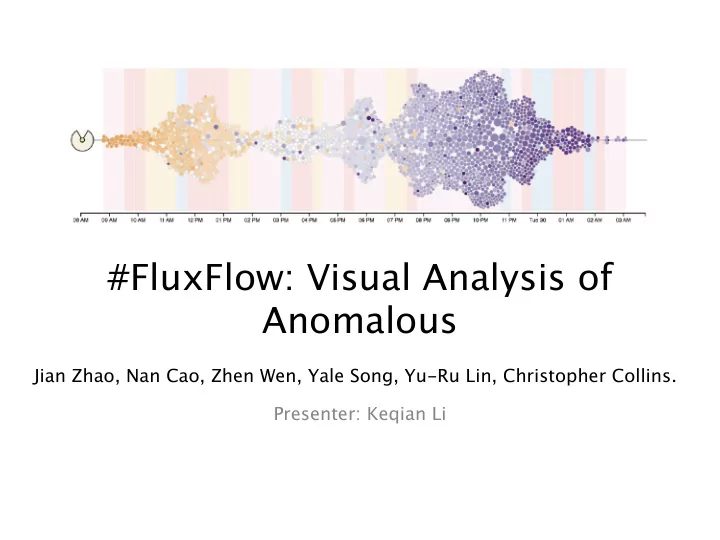

#FluxFlow: Visual Analysis of Anomalous Jian Zhao, Nan Cao, Zhen Wen, Yale Song, Yu-Ru Lin, Christopher Collins. Presenter: Keqian Li
What: SOCIAL MEDIA
Why: Abnormal conversational threads
How: FluxFlow
Abnormal Retweet Threads Detection: A Data mining approach • One-Class Conditional Random Fields Model (OCCRF) – temporal dependency, due to mechanism in RT time series data – one-class nature. There is little to no example (or even a clear definition) of true anomalies – contains a set of hidden variables to capture the underlying sub-structure of the sequential data • Extracted Feature for each single retweet – User profile features: counts of followers, friends, status – User network features: in-degree and out-degree – Temporal features: intervals between two adjacent tweets in the sequence
Data mining pipeline
RT Thread Visualization: RT Thread Glyph
RT Thread Visualization: RT Thread Timeline
System interface
Hierarchical cluster of RT threads by topics
MDS view of threads from high dimensional feature space
User social connections at the intra- or inter-thread level
Deep-Level Information for Input feature vectors, model hidden states, raw tweets
Visualization techniques summary How:Encode Glyph, Thread Timelines Multiform, Overview/ Detail. How-Facet linked highlighting. Item filtering, Item aggregation, How: Reduce Attribute aggregation, Elide, Superimpose How: Manipulate Highlighting, Project, Zoom
Task Summary T1 Summarizing and aggregating important features of • retweeting threads. – Glyph, Cluster View, MDS View T2 Indicating characteristics and connections of involving • users. – User relationship graphs T3 Revealing temporal patterns of information spreading. • – Thread Timeline T4 Facilitating visual data comparisons and correlations. • – Cluster View, MDS View T5 Accessing deep-level information of the model and • input. – Thread Timeline, Features View, Status View, Tweets View
Evaluation • Datasets: two 10% Twitter feed datasets collected during two significant events: – 2012 Hurricane Sandy(52 million tweets) – 2013 Boston Marathon Bombing(242 million tweets) • Baseline: One-Class SVM (OCSVM) [Scholkopf et al., 2001] • Ground truth: manually labeled by three annotators to based on reports after the events
Comparison Results Accuracies of OCCRF and OCSVM in correctly detecting rumors in the top-K retweeting threads ranked by the models in datasets: a) Hurricane Sandy, and b) Boston Bombing.
Case Study of Hurricane Sandy
Critiques Data • – Incorporate further content attribute(e.g., topics, tags, deeper semantic analysis) Data mining algorithm • – Improve on algorithm scalability and response time – Decouple with specific models – More insights about the model beyond hidden states, e.g. interactions of model parameters Visualization • – Timeline visualization need better reducing techniques to be scalable for real social network data – Better to show the “chain” of retweeting, and influence between users Evaluations • – Stronger ground truth for quantitative evaluation
Thank you
Recommend
More recommend